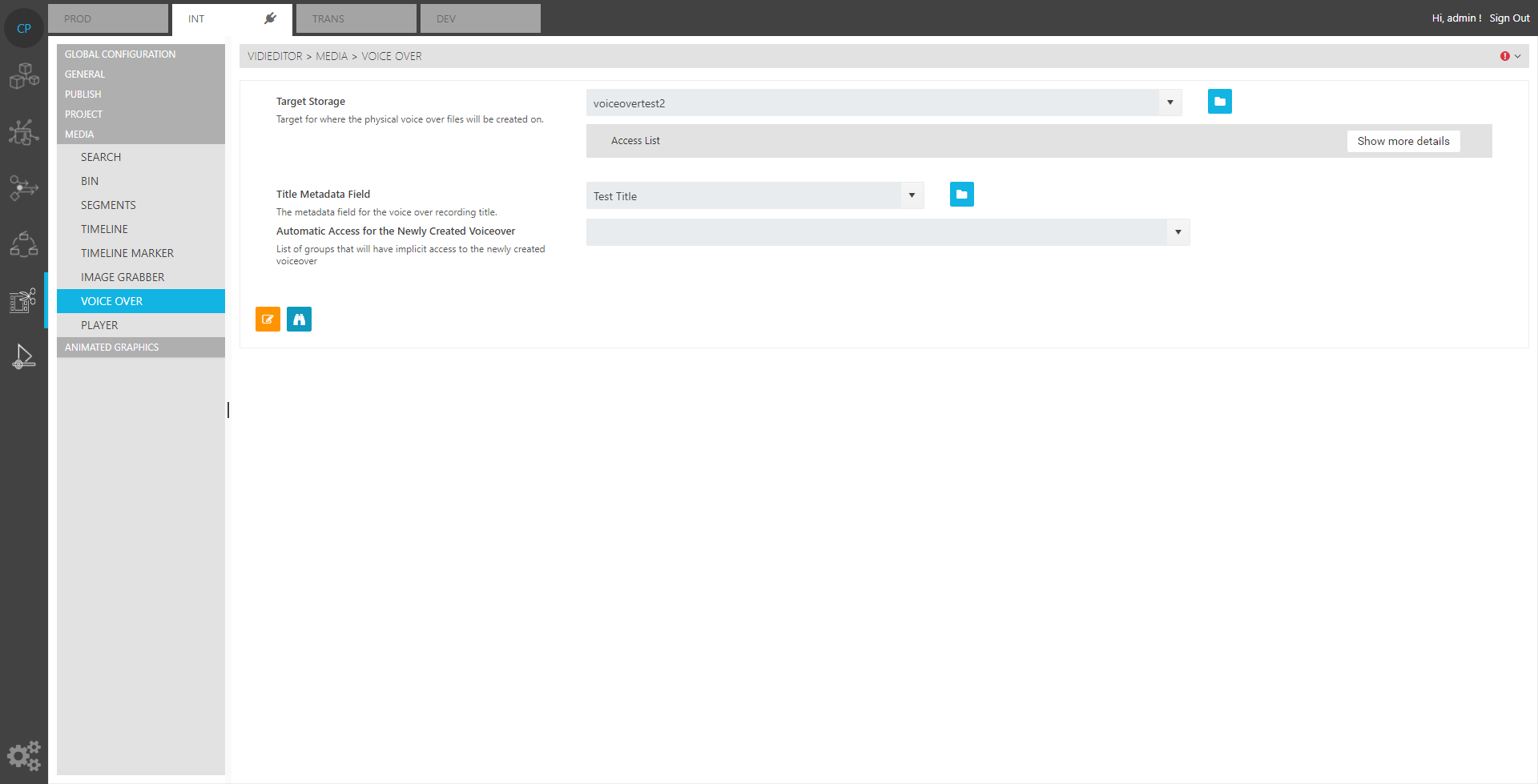Voice-Over Configuration and architecture
A common use case in video production is the use of voice-over recordings to speak on top of the video composition. This use case works out of the box after installation. Anyway a configuration pages exists to be able setting some essential parameters for the VidiEditor application.
ConfigurationPortal → VidiEditor → Media → Voiceover

Following configuration possibilities exist:
Target Storage: Sets the target storage for the recorded voiceovers when ingesting them to VidiCore
Title Metadata Field: Sets a custom metadata field of type string that is used to store the voiceovers name entered by the user
Automatic Access for the Newly Created Voiceover: Allows to assign a rule that is evaluated to set ACLs for the VO on ingest (see ACL Management)
Record
The user needs a microphone connected and enabled to be usable in the web browser in order to record audio. Please check the browser settings to enable microphone if a record is not possible. This can be done in Chrome:
chrome://settings/content/microphone
Local Media
The voiceover is recorded locally on the client PC and will not be ingested automatically to the central VidiCore system. Its processed directly in the web browser. The user can trigger an ingest for the local at any time to manage it centrally. This means that:
The voiceover is not protected by the MAM system as long as it is local
The voiceover is only accessable for a conforming of the timeline after ingest
The voiceover is only usable on the client used for recording until it gets ingested, then it can be used on a different client PC also
The local voiceover is persisted using the web browsers build in Indexed database that needs to be usable. It can be monitored inside the web debugger easily for troubleshooting reasons:

Those local recordings will persist also after ingest to allow a fast usage of VO in the GUI. They get deleted as soon as the deletion lock date is expired based on the configured deletion lock time of ConfigPortal (see General Configurations). The deletion lock of the local voiceovers will not be modified if a projects deletion lock changes. Anyway if the local voiceover got ingested to VidiCore it will be recreated in indexed database based on the central VidiCore media. If local media is deleted from indexed database before ingesting it will be lost.
Ingest
When a user chooses to ingest VidiEditor will import the audio to VidiCore record using VidiCoder. A specific shape tag is needed to define the target format. The shape tag will be added when installing VidiEditor automatically. It has a fixed name:
voiceover
By default, this is defined according to the specified audio format for streaming (see Supported Audio Format [VE OG]) in order to ensure it can be used for timeline streaming. The default shape tag is:
<?xml version="1.0" encoding="UTF-8" standalone="yes"?>
<TranscodePresetDocument xmlns="http://xml.vidispine.com/schema/vidispine">
<format>mp4</format>
<audio>
<codec>aac</codec>
<bitrate>192000</bitrate>
<framerate>
<numerator>1</numerator>
<denominator>48000</denominator>
</framerate>
<channel>0</channel>
<channel>1</channel>
<stream>2</stream>
</audio>
<video>
<noVideo>true</noVideo>
</video>
<metadata/>
</TranscodePresetDocument>This definition can be modified if needed. For example, one could use a WAV / PCM file for the record to avoid compression. This would work on the ingest side, however a proxy shape for usage in VidiEditor would be needed then on the same item.
Anyway after ingest the newly created voiceover will have 2 shapes in the default configuration:
original: Holding the raw recording data
voiceover: Holding the described streamable format to be usable in the players
Usage in Mix
The voice-over track in VidiEditor is indexed with the track counts 0 and 1. This ensures that the voice-over track is explicitly addressed when configuring a audio mix.
